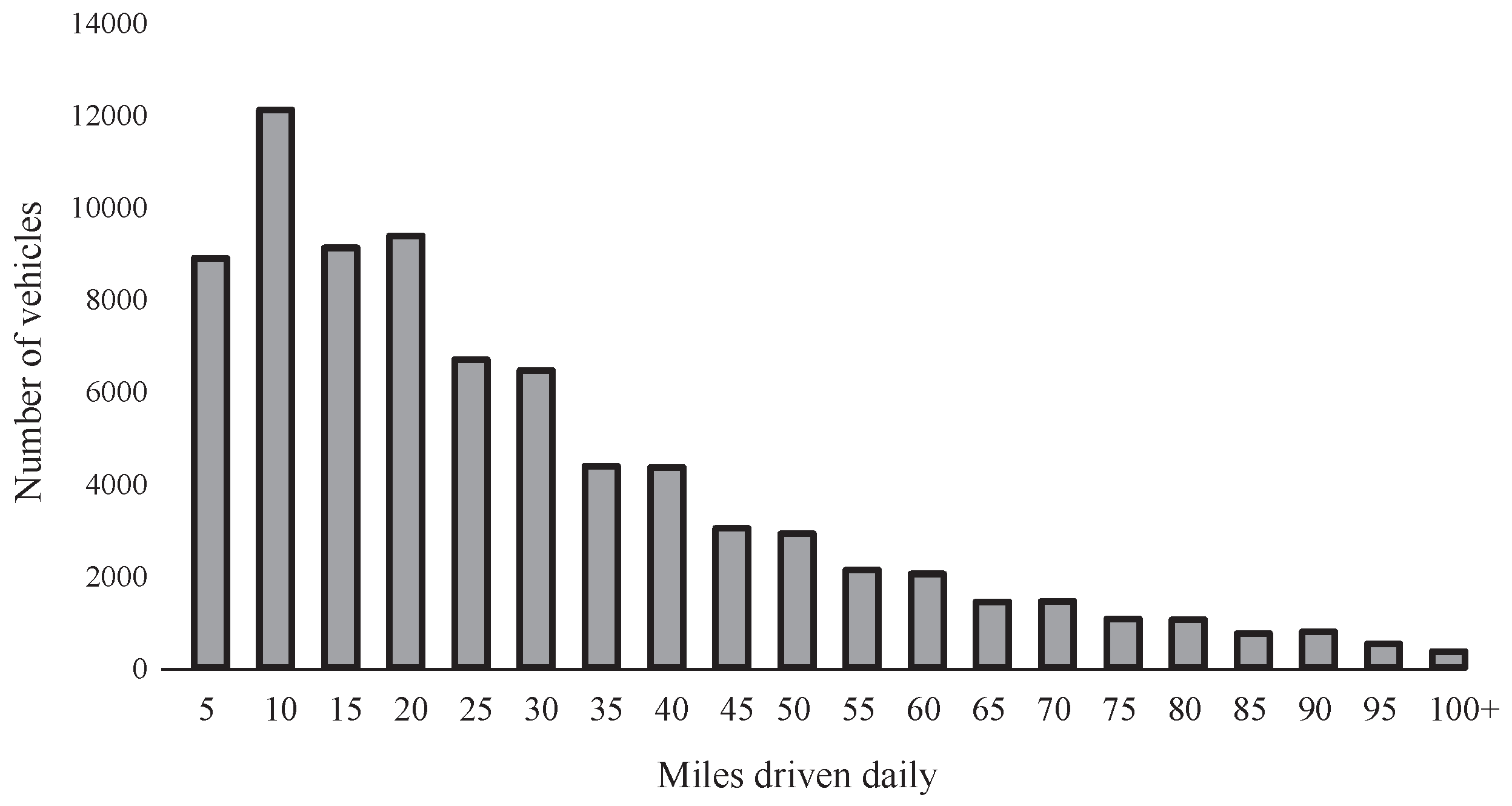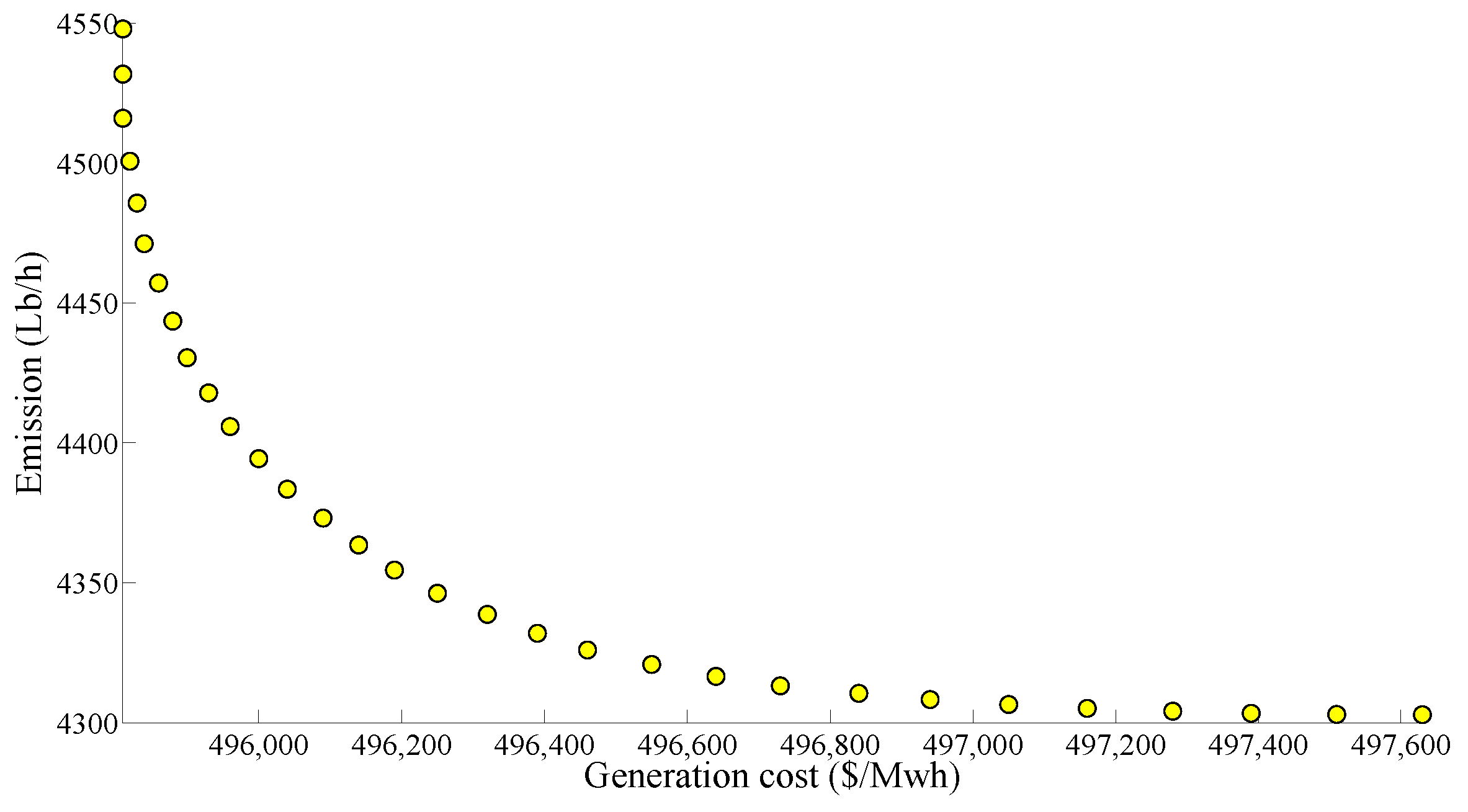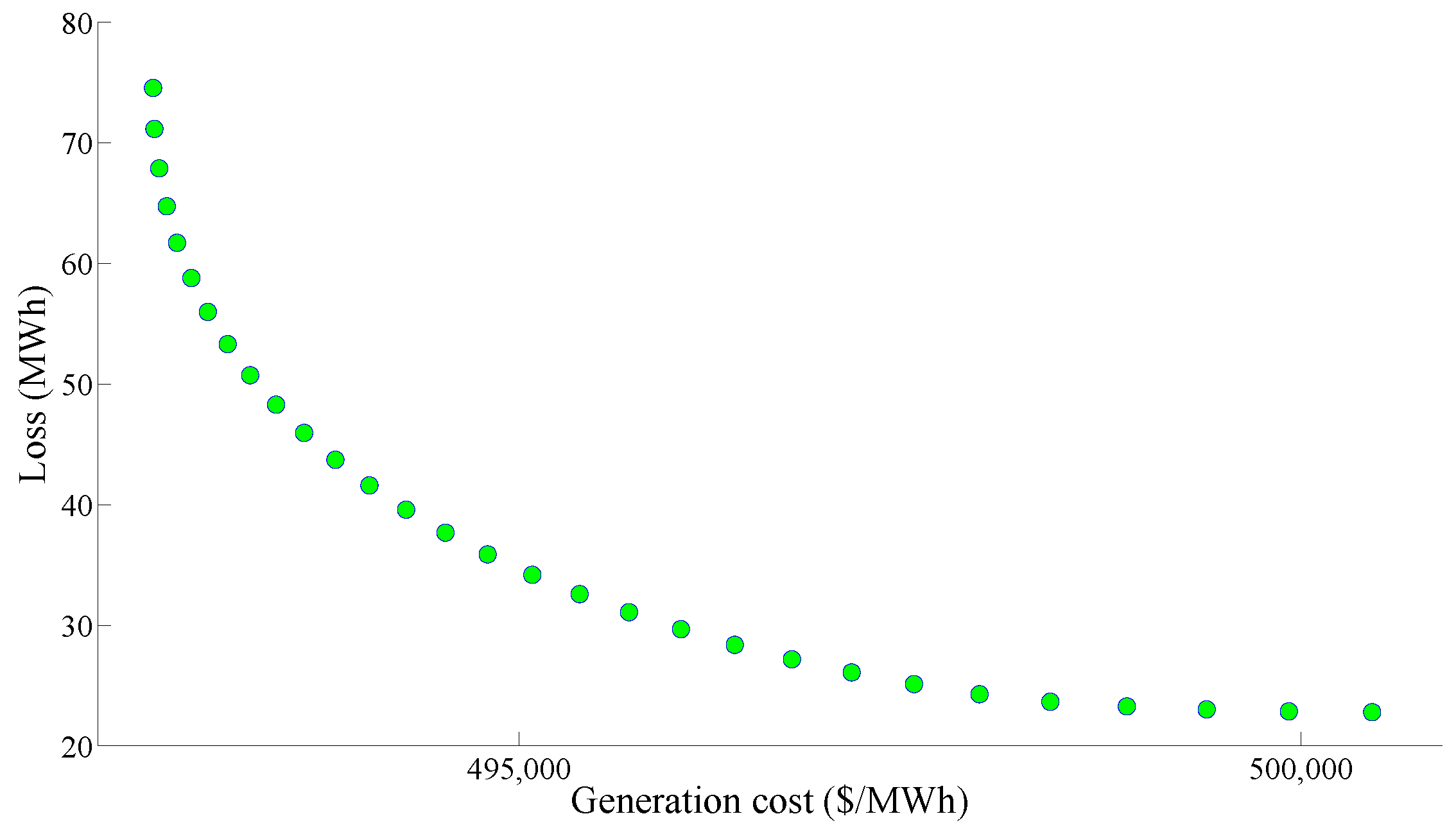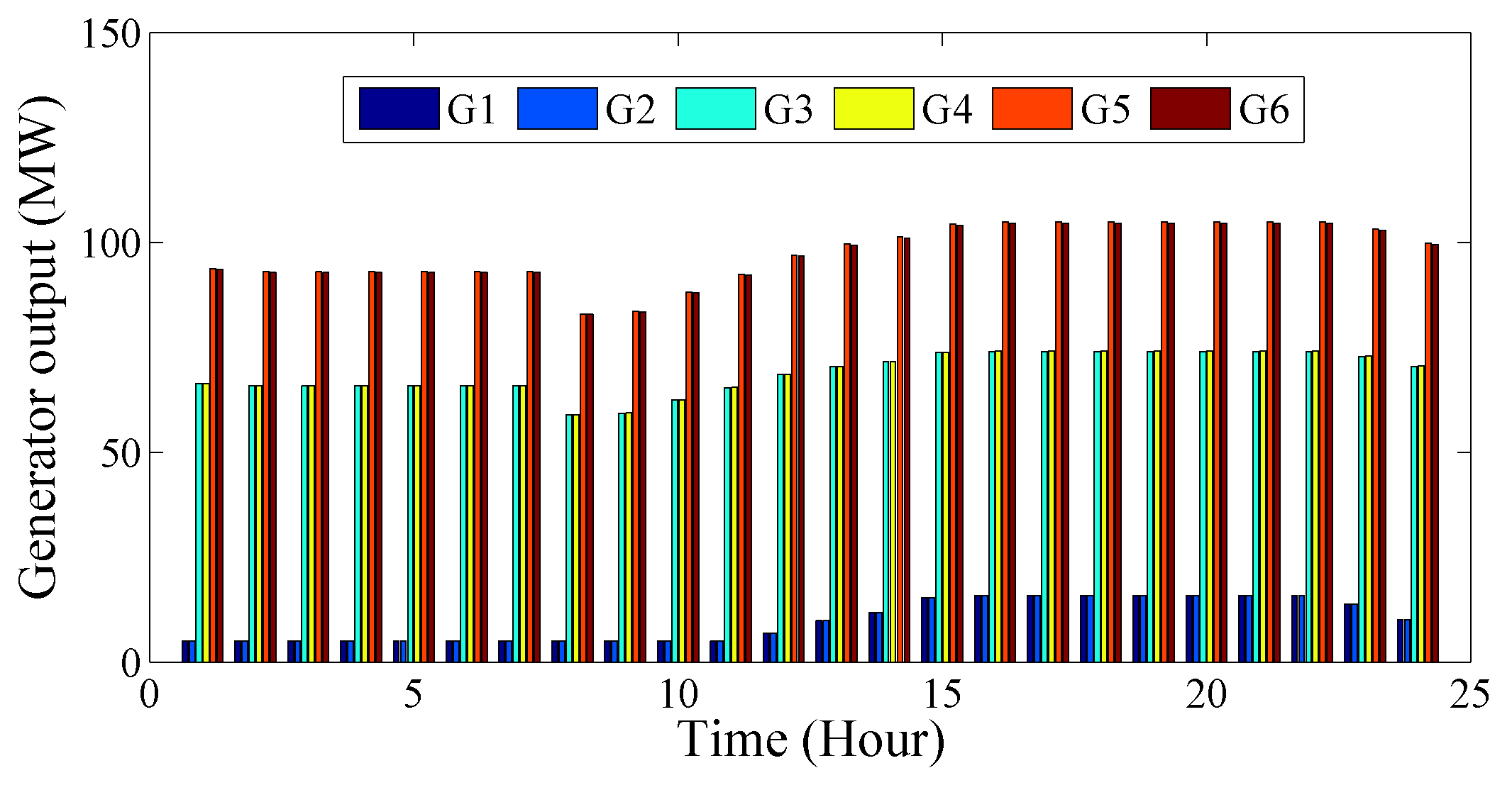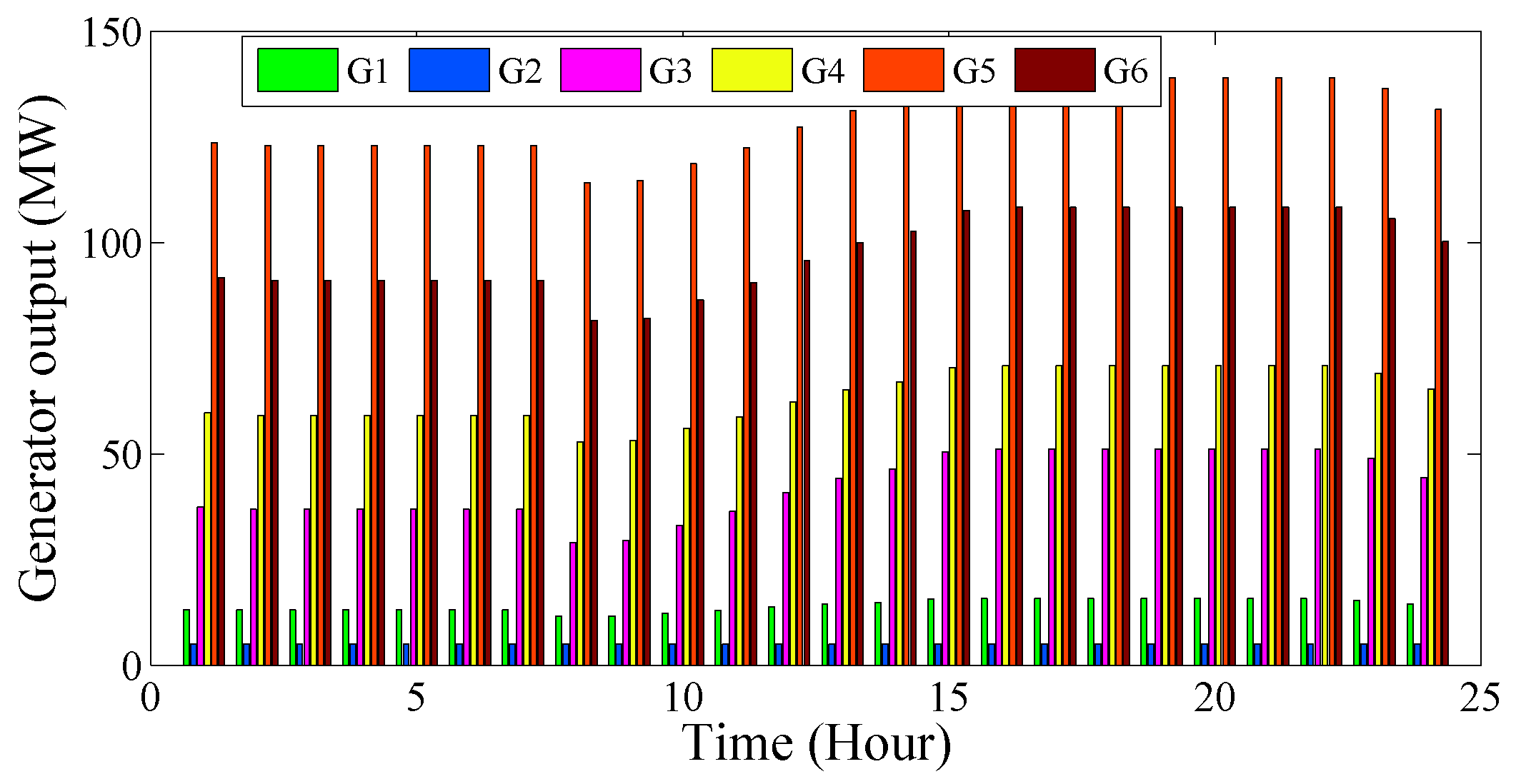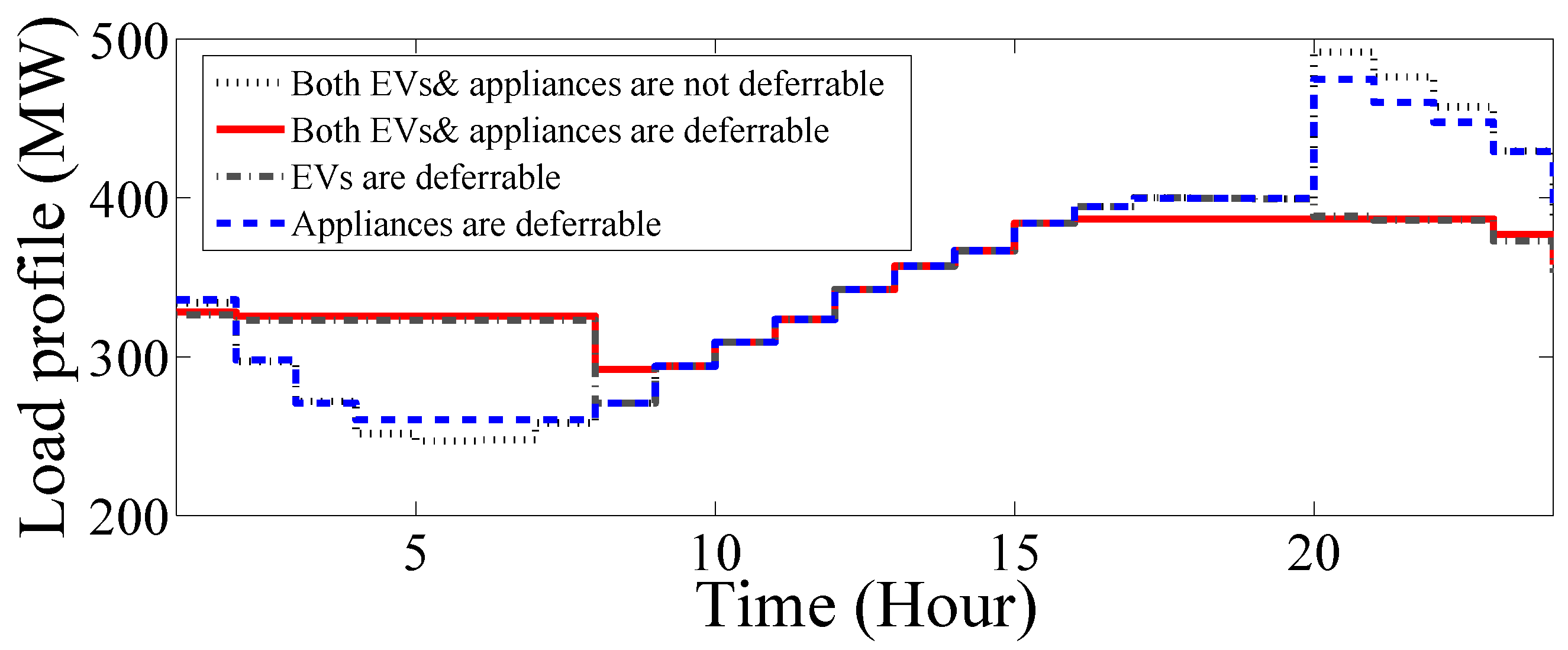1. Introduction
Demand side management is an approach through which consumer demand can be shaped to improve power system generation and load balance [
1,
2]. In addition, demand side management (DSM) programs may be implemented to improve load factors or to defer capital investment in system expansion. In the United States, demand response programs during 2011 generated approximately
$6 billion in direct revenues for local businesses, industry, and households through investment costs avoidance [
3]. For example, the Pennsylvania-Jersy-Maryland (PJM) seasonal peak was reduced by 7% through the implementation of regional DSM [
3].
The majority of current DSM applications target large industrial consumers due to ease of coordination coupled with a large return on investment [
4]. However, advances in communication technologies as well as load control at end-use points are expected to encourage further implementation of demand side management among smaller customers in residential and commercial sectors [
5,
6]. Home energy management systems will provide improved capabilities to coordinate load demand with market incentives through appliance load and Plug-in electric vehicle (EV) charging deferral and aggregation.
EV may become a significant portion of the future distribution load, and may also play a large role in DSM programs due to their flexibility in charging schedules. The penetration of EVs is expected to increase drastically in the next few years, which can reach one million by 2015 in US [
7]. It is because of their undeniable benefits such as reducing the emission level [
8,
9]. However, increasing the penetration level of EVs can burden the grid and, in the absence of a proper charging control strategies, it can easily overload the electricity grid at peak hours. In addition, uncoordinated charging of electric vehicles by the customers can impose problems on the distribution network like increasing the peak demand, voltage sags, congestion, thereby leading to increased losses, reduced component lives and bringing up of costly generators to serve the excess load. This might eventually result in a need for infrastructural reinforcements, increase in the price of electricity and power quality problems.
A good solution for preventing problems imposed by the EVs on the grid is to devise effective coordination techniques to optimally charge the vehicles on one hand and incentivize the customers to get enrolled in such programs on the other. An optimal charging strategy is one that charges the vehicle within the time available as per the customer’s convenience while considering the network loading e.g., reducing the peak-time connections and filling the valley in the load profile during night. This study proposed a charging model for EVs, which is explained in detail in the following section.
All of the above positive effects of DSM and EV coordination charging depend on customer participation in the load shifting programs. Financial incentives are not wholly sufficient to guarantee consumer participation in DSM programs; consumer comfort must not be significantly degraded, which requires assurances of appliance and vehicle availability. Therefore, the load shaping aspect of DSM requires an optimization that incorporates multiple, and possibly competing, constraints. In addition to load management, the utility provider may also desire to reduce operating costs and/or other functionalities such as carbon emissions or energy loss. Therefore, to fully exploit the load shaping capabilities of DSM programs, the DSM must be simultaneously coupled with an economic dispatch approach such that the overall system is optimized. Thus, a unified optimization must provide simultaneous schedules for both the generation and load, requiring a unified multi-objective approach to balance competing schemes for different considered objectives—here, generation cost, emission, and energy loss.
Over the past few years, rising concern over the environmental issues and the passage of the US Clean Air Act amendments of 1990 has forced the utilities to modify their operation strategies for generating the electric power at a lower pollution. In the past, some techniques have been presented to reduce the emission in power plant such as utilization of low-emission fuels, alternate energy resources, and emissions dispatching. In addition, flattening the load profile using demand response programs can preclude bringing up of high polluted generators to serve the excess load [
10]. The first two solutions require modification of the existing power plant or installation of some equipment, which require a large investment. Furthermore, the necessity of emission dispatching is changing the most economic generation schemes from an economic dispatch point of view. Therefore, the last solution can be more appropriate for reducing emissions compared with other techniques.
Another important issue in power system operation is the loss reduction, in which the system operator tries their best to minimize it as much as possible. In the process of transmitting the generated power, an estimated four percent of the total energy produced is lost. The economic viability of power systems, especially in a competitive energy market, demands an optimum mix of all of the parameters that influence power generation and transmission. An approach to achieving this optimum is to include the transmission losses as one of the objectives in the economic dispatch (ED) problem [
11]. To this, DSM is employed to reduce energy loss, besides generation cost and emission in this approach. Our proposed model aims to minimize the total electricity cost, loss, and emissions while considering user comfort, EV travel patterns, and EV electricity demand. Therefore, it is necessary to combine the demand side management and dynamic economic dispatch (DED) to take the generation and the demand into account.
Tons of studies have been dedicated to the dynamic economic dispatch problem and the effect of deferrable loads on power system operation during the past few years. Shao et al. presented a load shaping tool based on DR strategy to reduce the impact of EV on the distribution grid. They take customer preferences, comfort level and load priority into account [
12]. Their method is able to manage the total demand, preventing the transformer from being overloaded. However, the studied system is limited to a residential transformer serving three homes. In addition, EV contribution is included through a simple policy with no modeling of EV load management.
Abdi et al. proposed dynamic economic dispatch problem integrated with demand response. They derived economic models of the linear and nonlinear responsive loads for time-based and incentive-based demand response programs and integrated them with DED. However, the customer comfort and EV coordination is not considered in their approach [
13]. Papavasiliou and Oren proposed the unit commitment model for assessing the reserve requirements resulting from the large-scale integration of renewable energy sources and deferrable demand in power systems. They presented a demand response paradigm for assessing the benefits of shifting deferrable loads [
14]. Muratori et al. reviewed market-related problems of modern electric grids and possible solutions to address them. Specifically, they proposed a techno-economical solution, namely, residential demand response programs enabled by a smart grid [
15].
In our previous works [
16,
17], the effect of demand side management of appliances on the reliability, loss, and voltage profile of power systems are studied. Even though the customer comfort is taken into consideration, the economic aspects of the DSM are not evaluated. The impact of EVs on the demand profile is analyzed in [
18,
19], and the authors try to consider EV and demand response strategies. In both studies, EV contribution is considered through simple policies without mathematical modeling for EV coordination. In [
20], a game theoretic approach is proposed to schedule EV charging for load profile management. Vehicle-to-grid (V2G) capability has been considered in [
21], for developing an optimization problem in order to manage the load profile. Oviedo et al. [
22] proposed a coordination mechanism to allocate EV charging efficiently. An optimization-based model is presented in [
23] to perform load shifting in the smart grid environment. In this model, different agents for load, generation and storage management are defined and V2G is considered.
Efficient EV charging strategies are derived using EV traveling pattern in [
24,
25]. Rotering et al. proposed a dynamic programming based optimization method for one EV using available electricity prices and EV driving patterns [
26]. Wu et al. considered load scheduling and dispatch problem for a fleet of EVs in both the day-ahead market and real-time energy market [
27]. Nguyen and Le presented the joint optimization of electric vehicle (EV) and home energy scheduling in order to minimize the total electricity cost while considering user comfort preferences [
28]. Paterakis et al. presented a home energy management system for determining the optimal day-ahead appliance scheduling under hourly pricing and peak power limit based strategies [
29].
Muratori and Rizzoni presented a dynamic energy management framework to simulate automated residential demand response. The optimal schedule of all the controllable appliances, including electric vehicles, is found by minimizing consumer electricity-related expenditures [
30]. Mahmoodi et al. introduced a distributed economic dispatch strategy for microgrids with multiple energy storage systems. Their strategy overcomes the challenges of dynamic couplings among all decision variables and stochastic variables in a centralized dispatching formulation [
31]. Shamsi et al. proposed an agent based community microgrid for solving the dynamic economic dispatch (ED) problem in which each agent is capable of trading electricity with other agents through a local energy market [
32]. However, they didn’t take the DSM and EV effects into account.
The appliance scheduling and electric vehicle charging problems are often addressed separately in the literature, and, to the best of our knowledge, none of the previous works have considered a multi-objective based approach for detailed design and joint optimization of EV and building energy management. To this end, we propose a unified optimization model that jointly optimizes the scheduling of EVs and household appliances while different constraints including generator limits, load balance, and load shifting are observed. There are several techniques mentioned in articles to solve multi-objective problems such as reducing the multi-objective problem into a single objective one by treating other objectives as a constraint, or uniting all the objectives into a single objective function. There are some drawbacks associated with these methods, such as the limitation of the available choices and their prior selection need of weights or targets for each of the objective functions. In addition, the weighted sum method is often preferred to form the tradeoff surface. However, two major disadvantages exist: if the Pareto set is non-convex, the Pareto points on the concave parts of the trade-off surface will be missed and, for an even spread of the weights, the optimal solutions in the criterion space are not usually evenly distributed. To this end, a Pareto-based approach that can obtain a set of optimal solutions instead one is employed. In addition, this paper takes advantage of a fuzzy decision method to find the best Pareto optimal solution among all of the Pareto solutions based on the operator desire. Power system operators can select one of these solutions in accordance with their previous experience.
The proposed study focuses on the load rescheduling where there is no net reduction in the load, but it is rescheduled to different times over the time horizon. In general, if the consumption profile of a load is going to be manipulated, there must be some slack in its energy consumption. Slack is a measure of the potential of an energy load to be advanced or deferred without affecting earlier or later operations or outcomes. With this in mind loads, it can be divided into on demand, deferrable, and flexible loads categories. On demand loads are often directly connected with consumer action and must be supplied when requested, such as turning on lights, providing zero slack in operation. Deferrable loads may permit scheduling of the energy consuming action, with little physical consideration or cost associated with deferring or initiating the action; these are often atomic actions that once started run to completion, like a washing machine load. Flexible loads permit some elasticity in consumption, within certain constraints often associated with the physics of the process; charging a battery is an example [
33]. For brevity, only deferrable loads are considered in this study. Furthermore, postponing the process or load activities is easy because the load is discarded at a critical time so the process has to catch up later. To this purpose, just the postponing process has been considered for deferrable loads.
Some DSM methods proposed in literature affected the overall system demand only and did not use detailed load models in the network [
29], which can disturb the customer comfort. As a matter of fact, the success of a demand response program is directly tied to occupants’ perceived comfort and satisfaction. To this end, the proposed approach explicitly models these constraints in the optimization process by the consumers’ acceptable delay times (ADTs) and the penetration level of active consumers, which is the portion of responsive customers to total customers. An ADT presents the maximum period of time by which the operation of the associated appliance can be prolonged without disrupting the customers’ comfort. It is notable that the ADT for nondeferable loads is zero, since customers’ comfort will be sacrificed by any delay in their operation. Information on the ADT value for different appliances can be derived by exploring consumers’ preferences from questionnaires and survey data. In addition, the penetration level of active customers is defined as the average customers’ willingness to respond. Indeed, penetration level is the ratio of the number of active customers to the total number of consumers [
34]. An active customer is one who simply changes consumption of its responsive appliances upon receiving a signal from the load aggregator [
35]. It is worth noting that there are different ways to shift the loads such as rescheduling business operations to off-peak hours or at night, or immediate interruptions on operating machines in business premises for approximately one to two hours. Therefore, both forward and backward load shifting can be implemented to shave the loads. However, postponing the process or load activities is easy because the load is discarded at a critical time so the process has to catch up later. However, the quality of the process may not be consistent. Toward this end, only the postponing load shifting process is considered in this study.
In order to implement the proposed approach, every house should receive relevant input information from Load Serving Entities (LSE) and plans the operation of all electrical equipments [
35], which can be easily done by the recent technology. The proposed energy management framework introduced in this paper is centralized in the sense that all households receive a signal from the electric utility and simultaneously optimize their demand. We believe that a centralized solution is the preferred approach under current technological capabilities. Furthermore, since the control signal is sent by the aggregator, adaptation will be easier. Lastly, it can be contended that consumer confidence can be won through pricing incentives. Thus, in this study, a centralized scheduling approach has been presented.
The contribution of the proposed study is introducing a centralized multi-objective model for implementing the demand side management, without sacrificing customers’ comfort, to optimize the generation cost, loss, and emission in power system. Furthermore, the proposed approach is simple in concept and easy to implement. In addition, it can be expanded easily to implement in a larger case study with more generators and households.
4. Applications
The proposed optimization process is validated on the six-generator test system detailed in [
43]. The lower limit of all generators’ outputs has been changed in this study since it is not possible to turn off a generator in the DED problem and the total load must be less than or equal to the minimum generation limit of the system at each time interval. The optimization is performed using the General Algebraic Modeling System (GAMS), which is a high-level modeling system for mathematical programming and optimization. The coefficients for computing the generation cost and emissions, accompanied with the minimum and maximum generation limits for generators are given in
Table 3. To implement the DSM, a load profile is specified for each load in the system. For each appliance, a normalized load profile based on the customer consumption pattern is defined. The total load at each time step is then computed as the product of the normalized load profile, the maximum power consumption of the appliance, and the number of participating DSM customers. The aggregated load profile across all consumers is shown in
Figure 3. This load profile is for winter, so the peak load of the HVAC is during the evening. Load aggregators can gather the individual load profiles and responsive load values for all customers. Although similar appliance load profiles are assumed for all customers in this study, the general approach can be extended to include diverse load profiles for different customers.
To compare the effect of EVs and appliances on different objective functions, several scenarios including combinations of EVs and appliances as deferrable or nondeferrable loads are illustrated. The payoff table for the base case scenario (no deferrable loads) is given in
Table 4.
Table 5 gives the payoff table in the fully deferrable case. The payoff table values for varying ratios of EVs and loads will lie between these table values. Since the trend between the different objectives is inversely proportional, this implies that the combined objective functions form a Pareto front.
Since there are three objectives, three different combinations of objective functions can be obtained for two-dimensional Pareto fronts. These combinations are (a) generation costs and emissions, (b) generation costs and energy loss, and (c) energy loss and emissions. The Pareto fronts are shown in
Figure 4,
Figure 5 and
Figure 6 for the first scenario.
Each Pareto optimal solution is a valid choice for the system, depending on the operating objectives. The best compromise solution for each multi-objective case is given in
Table 6 and
Table 7 for different scenarios. A compromise solution is one in which two of the three objectives are minimized. The power system operator can select the best compromise solution based on the policy preference. Different Pareto optimal solutions, instead of one optimal solution, can give the system operator and/or policy makers multiple choices, and assess the tradeoffs between different objectives.
Given the same load profile, the generator outputs will be different depending on the optimization criteria. For example,
Figure 7 shows the generator dispatch curves for the case in which the emissions criterion has greater emphasis than generation cost (
Figure 8). When the dominant objective is to minimize emissions, the low emission units (G1–G3) produce more power throughout the day. However, when generation cost is the dominant factor, the low cost units (G4–G6) provide a much larger fraction of the overall generation.
In all cases, however, the optimal results are obtained when there is a significant amount of deferrable loads.
Figure 9 shows four cases:
Base case (no deferrable loads)
Only EV deferrable
Only appliances deferrable
Both EV and appliances deferrable
Figure 9 shows that the EV load dominates and its inclusion in the optimization yields improved results. Note when the EVs are not deferrable loads, there is a sharp peak at 7:00 p.m. due to the uncoordinated EV charging. By considering the EVs as deferrable loads, the load profile is significantly flattened and the severe peak is reduced. However, the total energy requirement over 24 h remains the same regardless of the load type (deferrable or nondeferrable).
